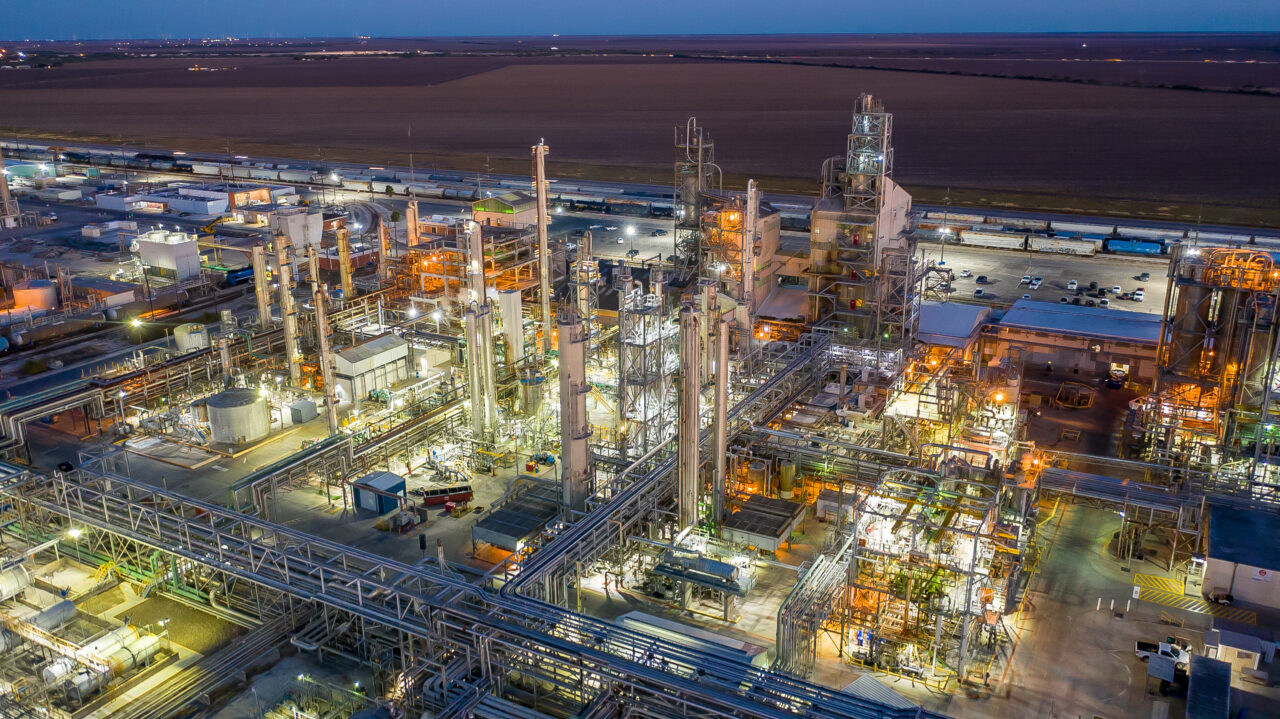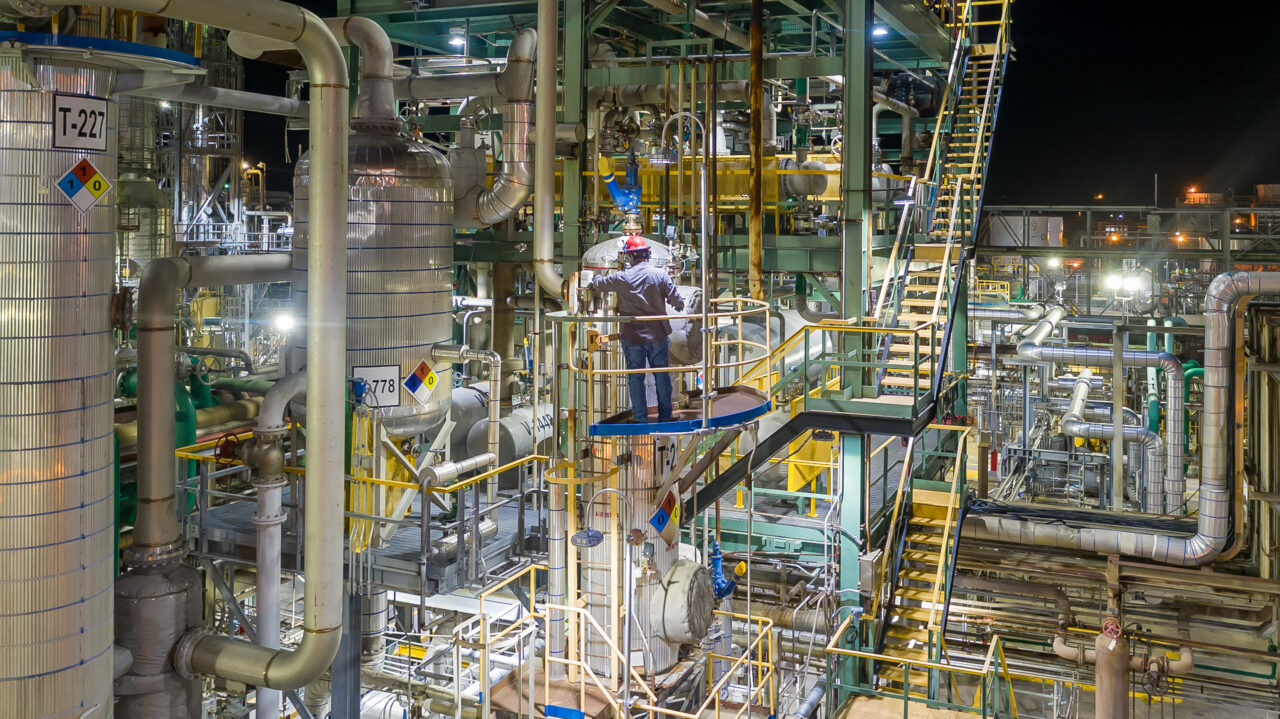Good lighting at CPI plants is important to prevent accidents. Improved safety can be achieved with LEDs, which are also more efficient and economical than alternatives

Figure 1. Lighting is important for safety at a chemical plant — from the parking lot to the production areas (Source: Dialight)
The chemical industry has long been plagued with safety challenges that make it one of the most hazardous manufacturing sectors of the chemical process industries (CPI). Causing over 18,500 injuries and 25 fatalities yearly on average, accidents in the chemical sector are both tragic and costly, with an annual cost of $676 million [1]. Aside from the harsh environment and risk of toxic exposure, the potential for slips, trips and falls alone are a major concern, with fall risk ranking as the number one OSHA (Occupational Health and Safety Admin.) violation for the tenth consecutive year.
While there can be many factors at play in chemical plant safety, poor lighting has been identified as the leading cause of slip, trip and fall accidents and accidents caused by contact with objects and equipment — the second most common types of industrial accidents [2]. In fact, upgrading facility lighting to improve illumination and visibility has shown to reduce accidents by as much as 60%. While it may seem obvious that lighting should be a key safety strategy, many organizations simply “make do” with inadequate lighting because it’s the status quo.
That had been the case at OQ Chemical’s Bishop, Tex. facility — that is, until senior instrument and electrical specialist Marcus Rubio arrived.
“When I came here in 2013 from our Bay City site, I noticed that we had about seven different types of lights in use — everything from metal halides and high-pressure sodium [HPS] to fluorescent, incandescent and even mercury vapor,” Rubio says. “That became one of my first goals: to standardize the lighting.”
As Rubio found, the inadequate lighting made for poor visibility in many areas. Not only did the lights fail frequently, requiring never-ending and costly routine maintenance, but even when they did work, the light quality itself was poor. Over the last eight years, Rubio has led a massive plant-wide retrofit to modern, industrial-grade light-emitting diode (LED) lighting, and the results have been “a positive for us, all around,” he says. “LED is the future of safe, efficient industrial lighting,” Rubio confidently asserts.

Figure 2. Good lighting can prevent tripping, slips and other accidents at a process plant (Source: Dialight)
Why LED leads in safety
As OQ discovered, industrial LEDs are not only more efficient and economical over the long term, but they make for a much safer work environment for employees, which helps lower the risk of accidents and the human and financial costs associated with them. Here’s how:
Better visibility. Unlike HPS and other antiquated lighting, industrial-grade LED provides bright, uniform lighting that reduces shadows and eliminates the need for auxiliary lighting like flashlights, which force staff to work one-handed. This improved visibility has proven to enhance trip hazard detection by nearly 24% and help workers identify trip hazards 94% faster [3].
Improved color rendering. The dark, orange glow of conventional HPS lighting makes it very difficult for workers to distinguish colors on wiring and safety labels, which can be extremely dangerous in a chemical facility. LED produces a crisp, white light that mimics natural daylight with a much more natural color rendering, allowing staff to easily discern safety-critical colors. “That was another big deciding factor for us,” Rubio said. “The light quality has been outstanding, and in seven years, we haven’t seen any decline in color rendering like we did with the competition.”
Lower fall risk. One of the major issues with conventional lighting is the ongoing maintenance. At OQ, as in many other facilities, that meant crews were often erecting scaffolding and working at dangerous heights just to change a light bulb. Because LED lighting lasts up to three times longer than conventional HPS and similar fixtures, it virtually eliminates the need for staff to work at height to replace bulbs. “We haven’t had to relamp a single light in almost seven years,” Rubio says of OQ’s Bishop facility.
Improved alertness. Especially in facilities with 24/7 operations, worker fatigue can be a serious safety issue. Not only is literally falling asleep on the job a concern, but fatigue can also slow reaction time and reduce alertness, putting sluggish workers at greater risk of an accident [4]. LED lighting has shown to improve alertness and reduce fatigue by a factor of five times compared to HPS by suppressing melatonin levels [5]. This not only enables workers to think more clearly but also improves their reaction time and efficiency to help them avoid accidents.
Corrosion resistance. Caustic materials — both chemical and salt spray in shoreline locations — can make quick work of conventional fixtures, eroding the fixture housing and causing premature failure. LEDs are much more resistant to corrosive materials with fully sealed fixtures that prevent ingress and corrosion-resistant housings designed to withstand the harsh environment of a chemical facility. This reduces the risk of fixture failure, which not only alleviates the maintenance burden, but also the risk of unexpected poor visibility when a critical light fails.
Hazardous location certified. The presence of potentially flammable airborne contaminants inside a chemical facility presents a huge risk to workers’ safety. Even with sealed conventional lighting, the frequent maintenance required forces crews to break the seal often for bulb changes, which risks an explosion. Not to mention, conventional fixtures run extremely hot, which can cause spontaneous combustion of any airborne particulates. LED fixtures not only require less maintenance, therefore lower the risk of explosion, but they also produce much less heat, making them safer for potentially combustible environments. A wide variety of models are now available with a range of hazardous location certifications especially for this purpose. “We decided to standardize on Dialight Class I Div 2 fixtures across the plant,” Rubio said of OQ. “We didn’t want to take a chance of installing a non-hazardous fixture in a hazardous location, so we played it safe and went with all Class I Div 2 for the added peace of mind.”
Shock and impact resistance. Conventional filament-style HPS bulbs and fluorescent tubes are notorious for failure and breakage due to their delicate nature. When this happens, it not only rains glass down over personnel, but it can also risk combustion if flammable materials are present. LEDs on the other hand, have no delicate bulbs to break and are much more resistant to vibration, shock and impact. In OQ’s welding shop, where pipefitters are often working with long pipe and conduit, the fluorescent fixtures were constantly getting broken. “With the [LED] fixtures, our welding and fabrication team now has much less shadow, better lighting and no worries about breaking glass tubes,” Rubio says.
Employee safety is the number one concern in any industrial facility and in the chemicals industry, where there are plenty of environmental hazards to worry about — lighting should never be one of them. As OQ and many others have discovered, upgrading to high-efficiency, long-lasting industrial LED lighting is an essential investment in reducing risk of accidents and injury both immediately and over the long haul.
References
1. U.S. Bureau of Labor Statistics, National Safety Council, ECG Analysis, www.nsc.org/newsroom, 2012.
2. U.S. Dept. of Labor, Census of Fatal Occupational Injuries Summary, 2016; Occupational Health and Safety Admin., Mine Safety and Health Admin., https://injuryfacts.nsc.org/work/work-overview/top-work-related-injury-causes.
3. Centers for Disease Control, National Institute for Occupational Safety and Health, www.cdc.gov/niosh/mining/topics/illumination.html.
4. Edwards, L. and Torcellini, P., A Literature Review of the Effects of Natural Light on Building Occupants, Technical Report, NREL, Golden, Colo., July 2002.
5. Falchi, F., Limiting the Impact of Light Pollution on Human Health, Environment and Stellar Visibility., J. of Environmental Management, Vol. 92, October 2011, pp. 2,714–2,722.
Author
 Fariyal Khanbabi is a CEO at Dialight Group (Leaf C, Level 36, Tower 42, 25 Old Broad St., London, EC2N 1HQ, U.K.; Phone: +44-203-058-3540) and chairman of Dialight Foundation. She is also the 2020 winner of Silver Stevie Award in the Woman of the Year – Manufacturing category. In the past, she occupied the position of chief financial officer (CFO) for Blue Ocean Group Ltd. and CFO at Britannia Bulk Holdings, Inc. and CFO at Britannia Bulk Plc (a subsidiary of Britannia Bulk Holdings, Inc.). She received an undergraduate degree from the University of Leeds.
Fariyal Khanbabi is a CEO at Dialight Group (Leaf C, Level 36, Tower 42, 25 Old Broad St., London, EC2N 1HQ, U.K.; Phone: +44-203-058-3540) and chairman of Dialight Foundation. She is also the 2020 winner of Silver Stevie Award in the Woman of the Year – Manufacturing category. In the past, she occupied the position of chief financial officer (CFO) for Blue Ocean Group Ltd. and CFO at Britannia Bulk Holdings, Inc. and CFO at Britannia Bulk Plc (a subsidiary of Britannia Bulk Holdings, Inc.). She received an undergraduate degree from the University of Leeds.